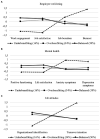Overbenefitting, underbenefitting, and balanced: Different effort-reward profiles and their relationship with employee well-being, mental health, and job attitudes among young employees
- PMID: 37051602
- PMCID: PMC10083407
- DOI: 10.3389/fpsyg.2023.1020494
Overbenefitting, underbenefitting, and balanced: Different effort-reward profiles and their relationship with employee well-being, mental health, and job attitudes among young employees
Abstract
We aimed to identify different, both balanced and imbalanced, effort-reward profiles and their relations to several indicators of employee well-being (work engagement, job satisfaction, job boredom, and burnout), mental health (positive functioning, life satisfaction, anxiety, and depression symptoms), and job attitudes (organizational identification and turnover intention). We examined data drawn randomly from Finnish population (n = 1,357) of young adults (23-34 years of age) collected in the summer of 2021 with quantitative methods. Latent profile analysis revealed three emerging groups in the data characterized by different combinations of efforts and rewards: underbenefitting (16%, high effort/low reward), overbenefitting (34%, low effort/high reward), and balanced employees (50%, same levels of efforts and rewards). Underbenefitting employees reported poorest employee well-being and mental health, and more negative job attitudes. In general, balanced employees fared slightly better than overbenefitting employees. Balanced employees experienced higher work engagement, life satisfaction, and less depression symptoms. The findings highlight the importance of balancing work efforts with sufficient rewards so that neither outweighs the other. This study suggests that the current effort-reward model would benefit from conceptualizing the previously ignored perspective of overbenefitting state and from considering professional development as one of the essential rewards at work.
Keywords: effort–reward imbalance; employee well-being; job attitudes; latent profile analysis; mental health.
Copyright © 2023 Li, Kaltiainen and Hakanen.
Conflict of interest statement
The authors declare that the research was conducted in the absence of any commercial or financial relationships that could be construed as a potential conflict of interest.
Figures


Similar articles
-
Job boredom as an antecedent of four states of mental health: life satisfaction, positive functioning, anxiety, and depression symptoms among young employees - a latent change score approach.BMC Public Health. 2024 Mar 27;24(1):907. doi: 10.1186/s12889-024-18430-z. BMC Public Health. 2024. PMID: 38539113 Free PMC article.
-
The effectiveness of mindfulness based programs in reducing stress experienced by nurses in adult hospital settings: a systematic review of quantitative evidence protocol.JBI Database System Rev Implement Rep. 2015 Oct;13(10):21-9. doi: 10.11124/jbisrir-2015-2380. JBI Database System Rev Implement Rep. 2015. PMID: 26571279
-
Reciprocity and job mobility: The effect of effort-reward imbalance in the employer-employee relationship on turnover intentions and actual job changes.Soc Sci Res. 2025 Mar;127:103133. doi: 10.1016/j.ssresearch.2024.103133. Epub 2025 Jan 10. Soc Sci Res. 2025. PMID: 40087001
-
Job strain, effort-reward imbalance and employee well-being: a large-scale cross-sectional study.Soc Sci Med. 2000 May;50(9):1317-27. doi: 10.1016/s0277-9536(99)00388-3. Soc Sci Med. 2000. PMID: 10728851 Review.
-
The inverted-U model of employee happiness: examining overdose happiness in context of personal characteristics, job-relationship dependency, benign stress, and various theories.Front Psychol. 2024 May 21;15:1285070. doi: 10.3389/fpsyg.2024.1285070. eCollection 2024. Front Psychol. 2024. PMID: 38836241 Free PMC article. Review.
Cited by
-
Job boredom as an antecedent of four states of mental health: life satisfaction, positive functioning, anxiety, and depression symptoms among young employees - a latent change score approach.BMC Public Health. 2024 Mar 27;24(1):907. doi: 10.1186/s12889-024-18430-z. BMC Public Health. 2024. PMID: 38539113 Free PMC article.
-
Configurational paths to turnover intention among primary public health workers in Liaoning Province, China: a fuzzy-set qualitative comparative analysis.BMC Public Health. 2024 Feb 5;24(1):369. doi: 10.1186/s12889-024-17881-8. BMC Public Health. 2024. PMID: 38317139 Free PMC article.
References
-
- Adams J. S. (1965). “Inequity in social exchange” in Advances in Experimental Social Psychology. Vol. 2. ed. L. Berkowitz (New York: Academic Press; ), 267–299.
-
- Ashforth B. E. (2016). Distinguished scholar invited essay: exploring identity and identification in organizations: time for some course corrections. J. Leadersh. Organ. Stud. 23, 361–373. doi: 10.1177/1548051816667897 - DOI
-
- Ashforth B. E., Mael F. (1989). Social identity theory and the organization. Acad. Manag. Rev. 14:20. doi: 10.2307/258189 - DOI
-
- Asparouhov T., Muthén B. O. (2014). Auxiliary variables in mixture modeling: using the BCH method in Mplus to estimate a distal outcome model and an arbitrary secondary model. Mplus Web Notes 21, 1–22.
LinkOut - more resources
Full Text Sources

